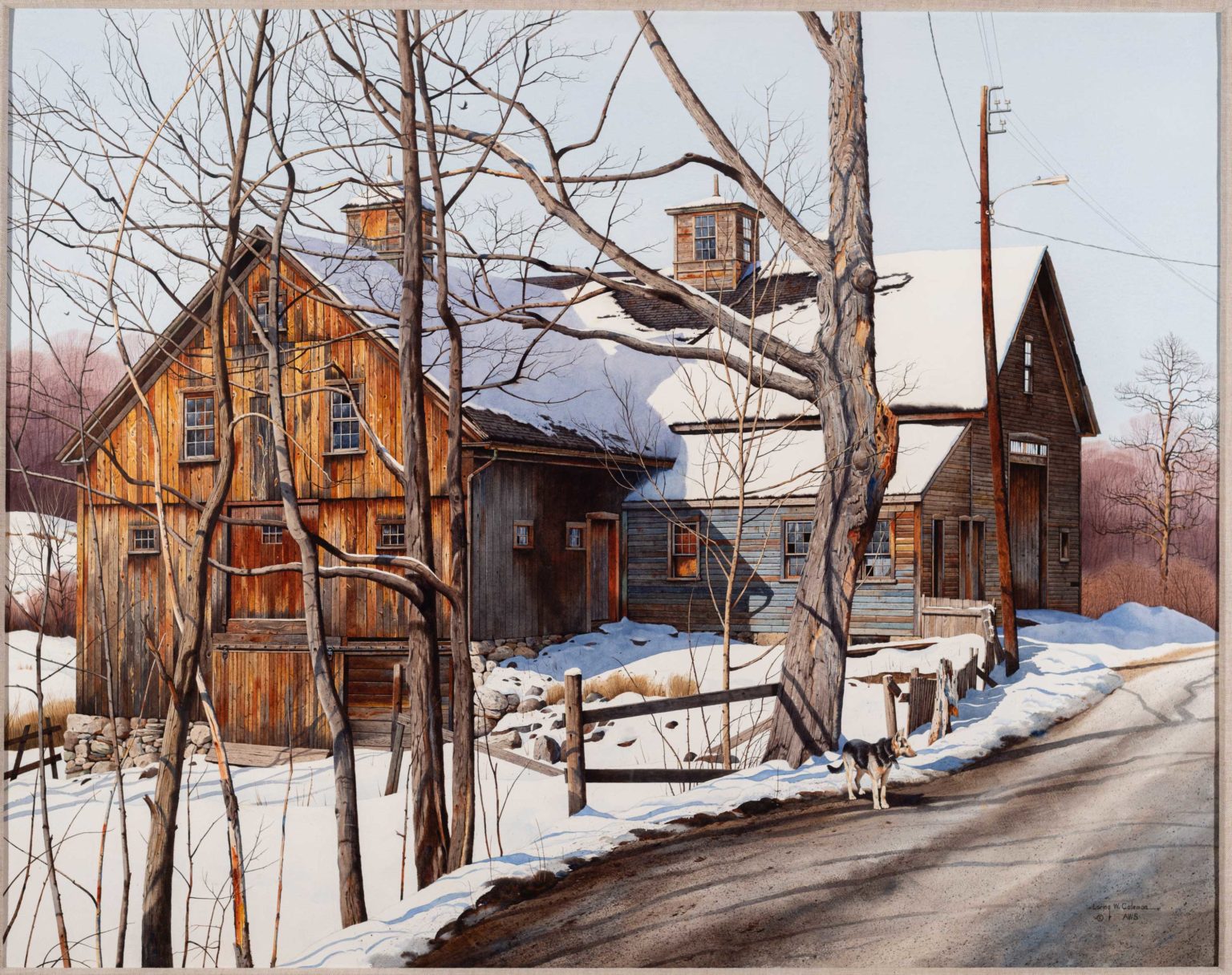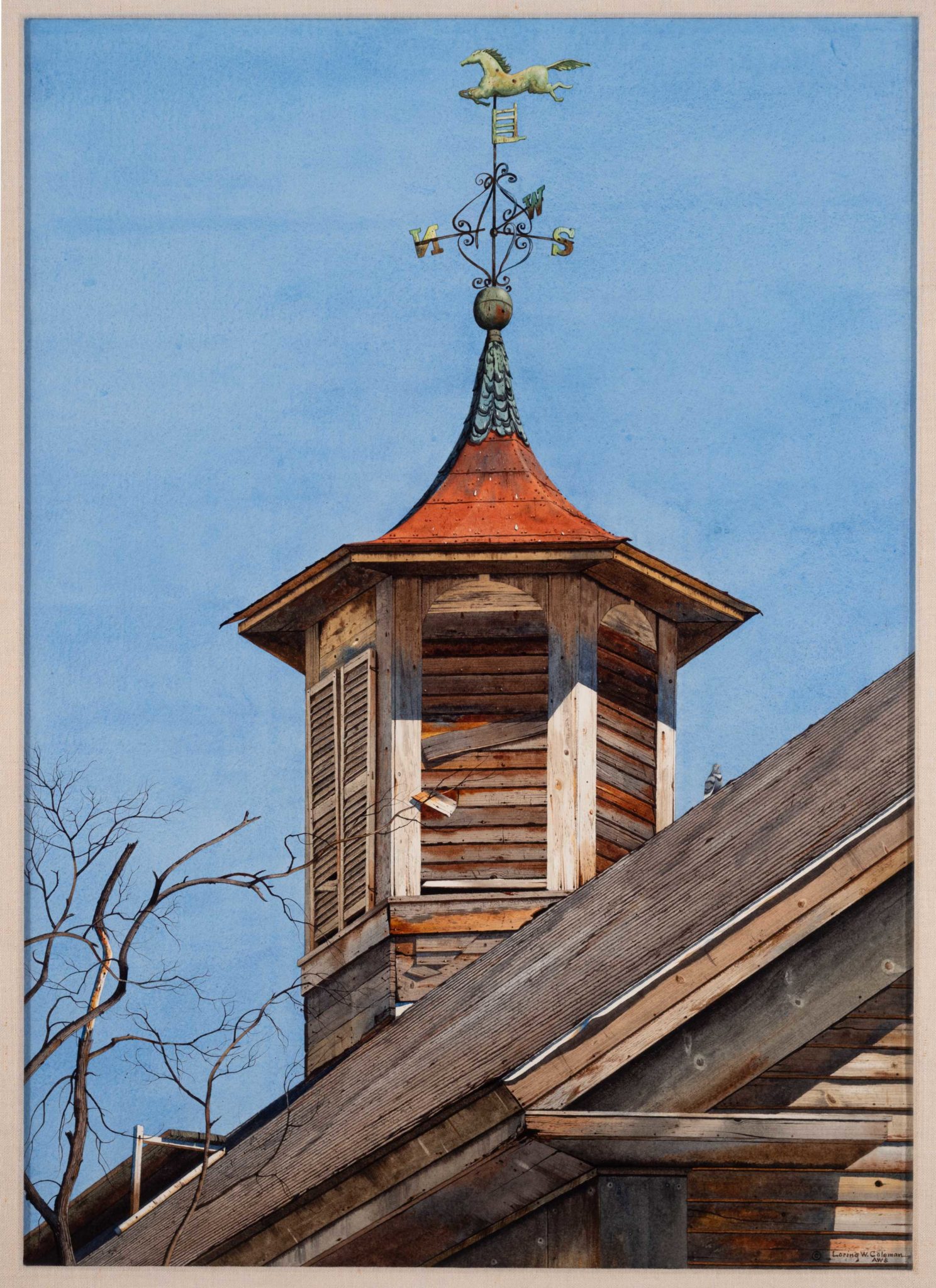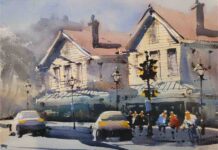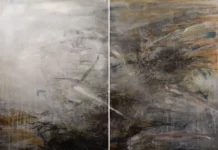An exhibition titled “Home” by Loring W. Coleman, a notable plein air painter of New England landscapes, will be on display at The Concord Museum through January 31, 2021.
In his 2011 autobiography, Coleman wrote about the exhibition’s title painting:
“Home … the title speaks for itself, for the painting represents the old farmhouses that still remain in New England and in my thoughts.”

In 2017, the Concord Museum received an anonymous gift of 47 works of art by Loring Wilkins Coleman. Curator David Wood explained, “We are pleased to present this new exhibition that celebrates the work of an accomplished artist who had a strong Concord connection and who explored a changing New England with a sense of wonder and authenticity.”
“Home” will feature 26 of Coleman’s works in watercolor, which reward close looking. Drawn from real-life subjects in and around Massachusetts primarily, they are often monumental in size and incredibly detailed. Though he trained in oil painting, Coleman primarily worked in watercolor, a technique he taught himself. Watercolors let him play with tone, texture, and abstraction; they also require precision and speed. As Loring Coleman explained, “All painting is exciting, but watercolor painting is no easy matter. It doesn’t give the painter time to contemplate, because the paint is drying before his eyes and he has to move ahead quickly.”

Why this fascination with the old farms of New England, particularly the crumbling barns? Henry Adams, Ruth Coulter Heeds Professor of Art History, Case Western Reserve University, said “I think Loring Coleman was inspired by different crosscurrents of emotion, and it’s the interweaving of these crosscurrents that makes his painting authentic rather than trite. At the root of his emotional response to these things is something that clearly goes back very early, to his happy experiences on his grandparents’ farm in Concord, a respite from the misery of his childhood in 1930s Chicago.
“Skilled with a gun or a fishing rod, gifted at woodman’s skills, handy at farm chores, he found a world he could master and in which he could excel. At the same time, what’s astounding about these paintings is the sense of sorrow and loss that runs through them- a sorrow over the decay and disappearance of the rural New England he knew as a boy.” (From the Foreword to the 2011 autobiography, “Loring W. Coleman: Living and Painting in a Changing New England,” published by Hard Press Editions)

“Coleman’s paintings are composites of familiar subjects, including old barns, houses, or roads set with dramatically scaled, and even haunting, composition. Dilapidated buildings, bare trees, peeling paint, and rusted vehicles are common features. Yet, there is beauty amidst the wreckage,” said Curator David Wood.
After a childhood in Chicago, Coleman lived at his grandmother’s Concord house, Tanglewood, on 200 acres overlooking the Sudbury River. He attended Middlesex School, where he was taught by Russell Kettell, whose influence on the Concord Museum is extensive. After service in War War II, Coleman taught for many years, including twenty-seven years at Middlesex School, while exhibiting his work across the country. He was an Academician of the National Academy of Design and a member of the American Watercolor Society, Concord Art Association, and Salmagundi Club.
Loring Coleman’s Painting Inspiration

On “Home”
“In 1982, my son Andrew gave me driving directions for locating a farm in Sterling, Massachusetts … I had no problem finding the farm and it was indeed one of the most handsome New England farms I had ever seen: a very stately house, a large barn, and three other buildings, some attached to the barn. What a beautiful site! … [In 2003] out of curiosity … I drove back to the farm, and every single building was gone except the house! I titled the painting ‘Home’. The title speaks for itself, for the painting represents the old farmhouses that still remain in New England and in my thoughts.”
On “Spectral Barn”
“As I began my drawing, a light drizzle soon changed to a very fine snow, almost like salt. The effect was startling. The barn gradually began to fade away, enveloped by the grey mist, so that the sky and barn became the same color. Only the faintest outline of the barn remained, accented by a few barn windows. I wondered at the value change in the grey-green stone wall as it receded. The ground was covered with frozen leaves. They too receded, lightened and disappeared in the distance. Only the striking dark tree and the black opening of the shed doors seemed to hold the composition together.”
On “New England Classic”
“A quintessential New England farm—Helen Gay’s barn and home, on Gay Road in Groton—sat right next to the old farm road. Helen and her daughter came out of the house each day to watch me paint. In my mind, the German Shepherd, from quite another farmyard, seemed like an appropriate visitor to the scene.”

On “Blue Door”
“When Tinka and I were on a cruise in Norway, we went ashore for a long, uphill walk through the town of Bergen. Exhausted, we sat down at the side of the road, and when I looked up, I was facing this wonderful door. I made a little pencil sketch, and I was so taken by the unusual color of the door, I placed my camera up close to take detailed photographs so that I could accurately render the beautiful blue when I returned to my studio.”
For more must-see shows like this one, sign up for our free weekly e-newsletter.








Loring Coleman’s paintings in watercolor are magnificent. How can I learn more about his work?
Thanks you.
Donna Goodell
[email protected]
Such a wonderful artist! Thank you, Kelly, for this article. I had never heard of him, and I’m thankful to have stumbled across this article on Google. I plan on using him as an inspiration, perhaps buying his autobiography. I’ve also signed up for your newsletter. Keep ’em coming!
Thank you, Kelly, I enjoyed reading about this masterful painter. I’d not heard of him. The work is beautiful and somber.